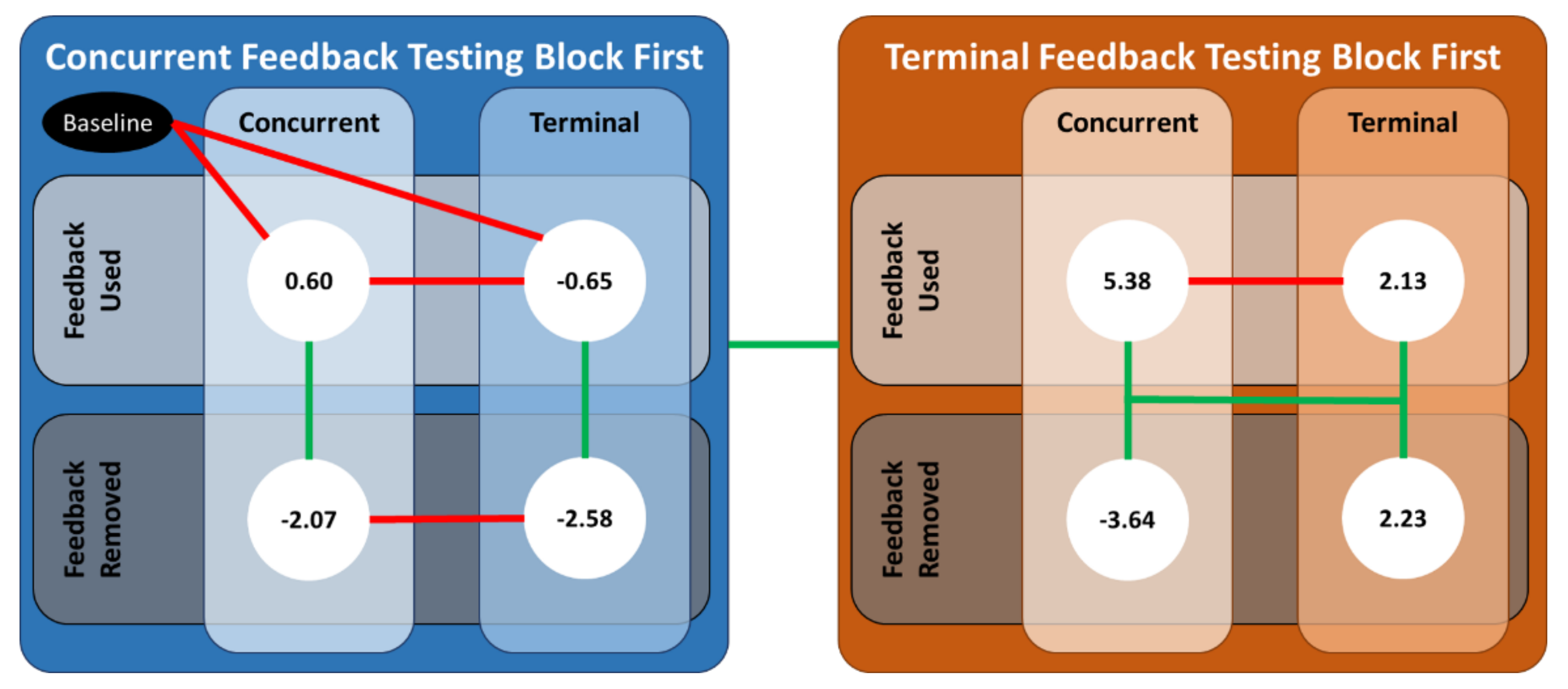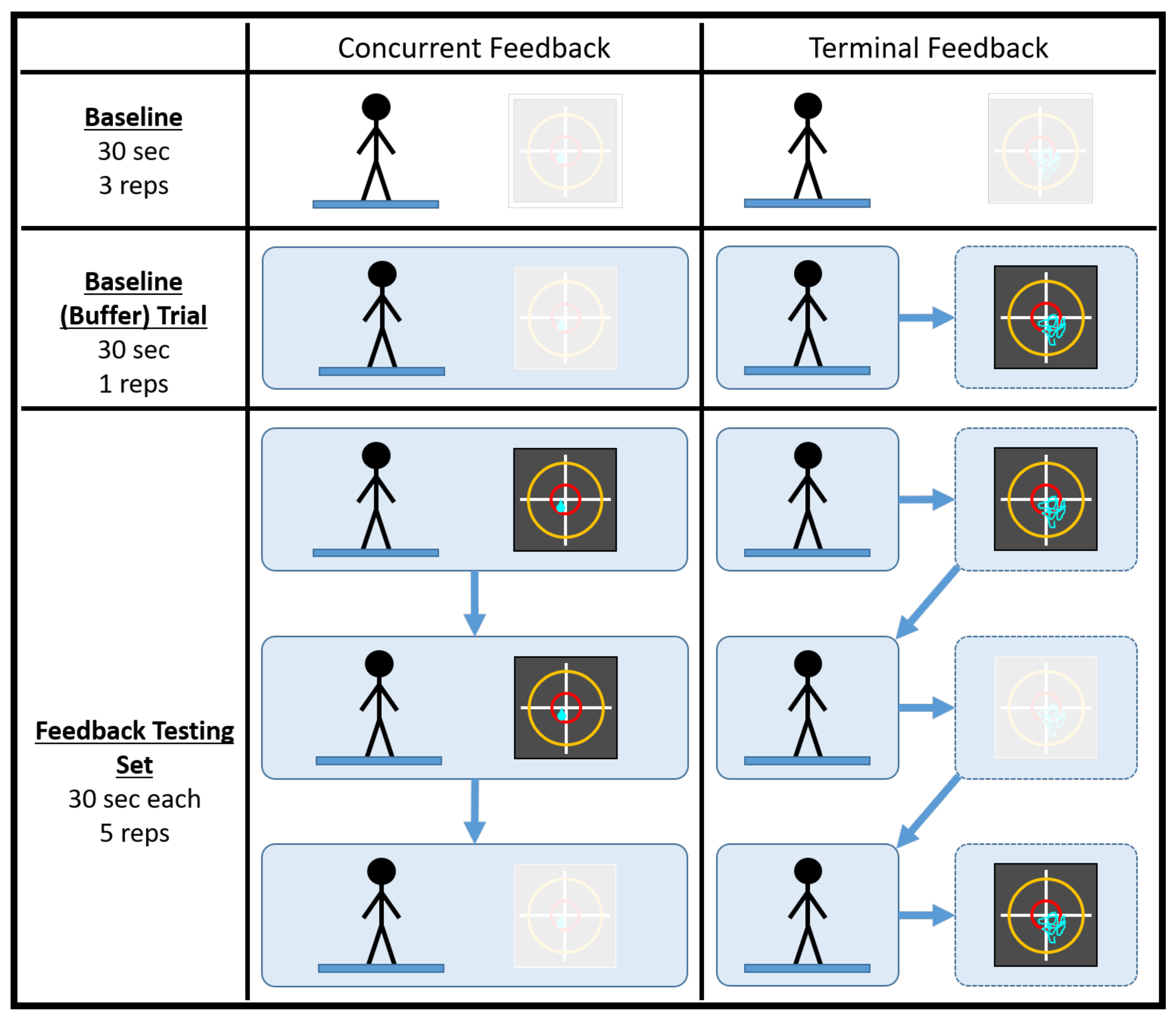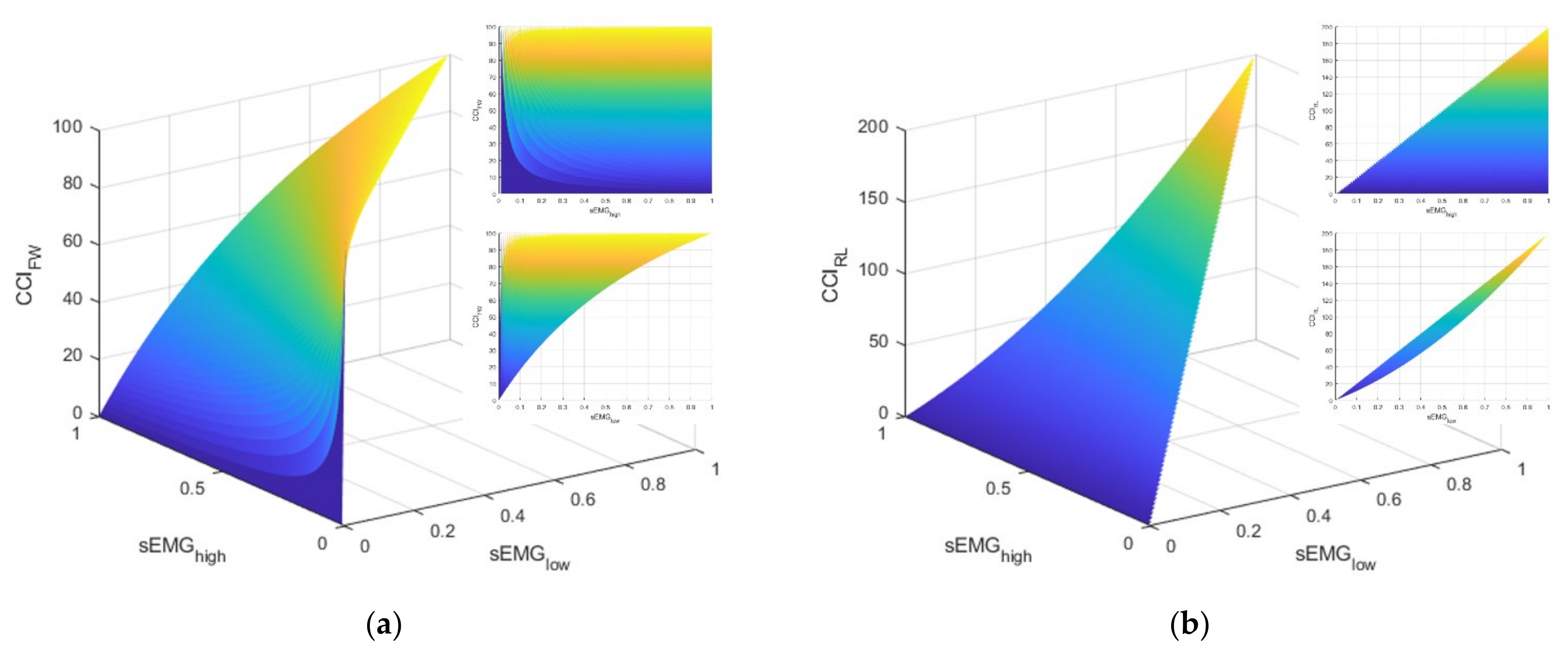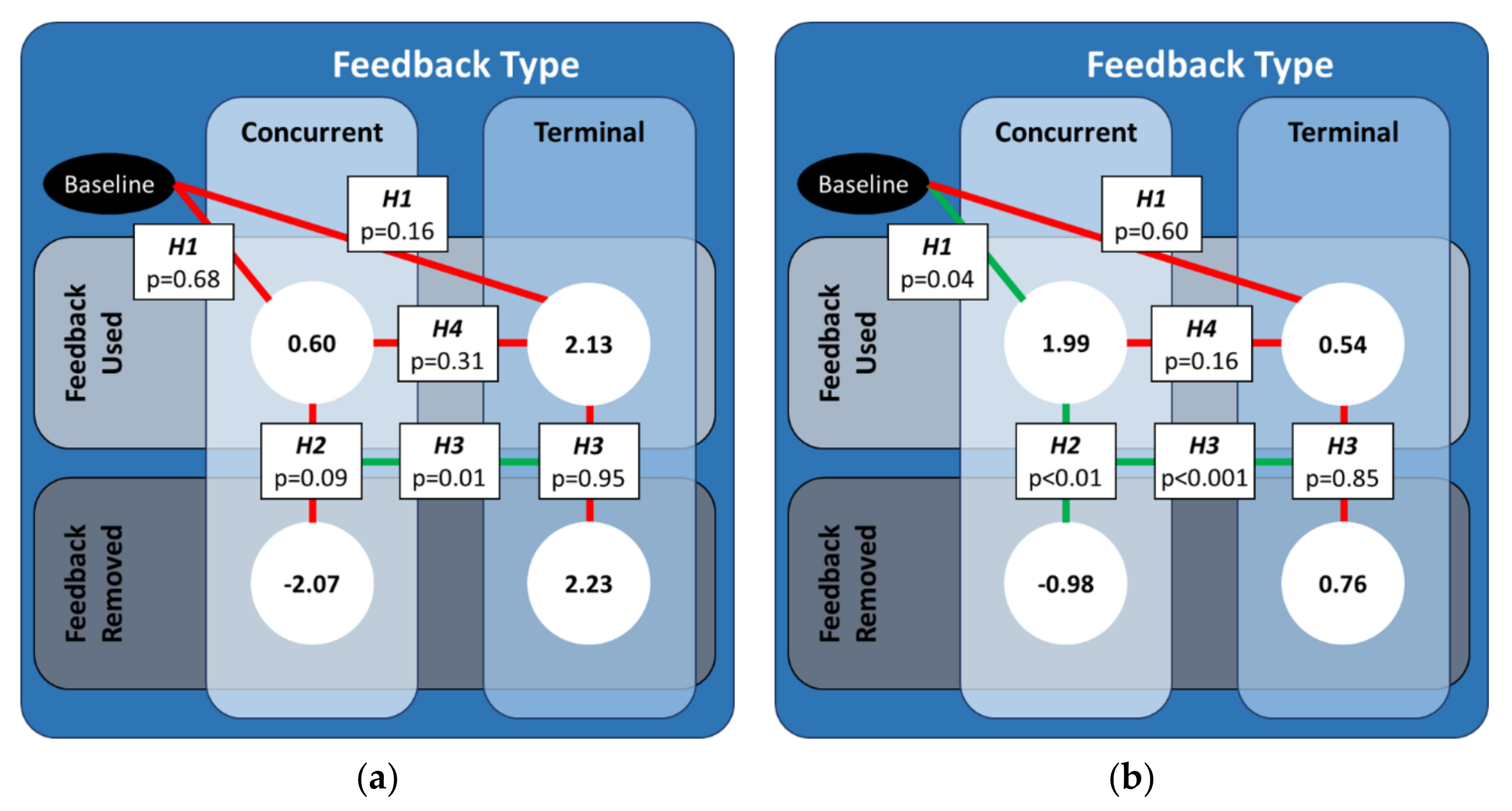Effects of Concurrent and Terminal Visual Feedback on Ankle Co-Contraction in Older Adults during Standing Balance
Abstract
:1. Introduction
2. Materials and Methods
2.1. Participants
2.2. Experimental Protocol
2.3. Surface Electromyography
2.4. Co-Contraction Index
2.5. Statistical Analyses
3. Results
3.1. Reliability Analysis Results
3.2. Linear Mixed-Effects Regression Results
4. Discussion
5. Conclusions
Author Contributions
Funding
Institutional Review Board Statement
Informed Consent Statement
Data Availability Statement
Acknowledgments
Conflicts of Interest
Appendix A
| Coefficient | CI:LB | CI:UB | p-Value | |
|---|---|---|---|---|
| Main Fixed Effects | ||||
| (Intercept) | −0.34 | −2.81 | 2.14 | 0.79 |
| type (concurrent) | −1.02 | −2.46 | 0.42 | 0.16 |
| removal (feedback given) | −2.17 | −3.93 | −0.41 | 0.01 * |
| order (concurrent first) | 1.21 | −2.40 | 4.81 | 0.51 |
| Fixed Interaction Effects | ||||
| type*removal | −0.74 | −3.25 | 1.78 | 0.57 |
| type*order | 1.75 | −0.34 | 3.84 | 0.10 |
| removal*order | −2.24 | −4.80 | 0.32 | 0.09 |
| type*removal*order | 5.67 | 2.00 | 9.33 | <0.01 † |
| Random Effects | ||||
| ID | 2.78 | 1.47 | 5.27 | - |
| ID:leg | 3.32 | 2.29 | 4.81 | - |
| Coefficient | CI:LB | CI:UB | p-Value | |
|---|---|---|---|---|
| Main Fixed Effects | ||||
| (Intercept) | 12.81 | 2.48 | 23.13 | 0.02 * |
| type (concurrent) | −18.92 | −25.28 | −12.56 | <0.001 ‡ |
| removal (feedback given) | −20.09 | −27.87 | −12.30 | <0.001 ‡ |
| order (concurrent first) | 22.54 | 7.54 | 37.54 | <0.01 † |
| Fixed Interaction Effects | ||||
| type*removal | 10.09 | −1.04 | 21.22 | 0.08 |
| type*order | −14.49 | −23.72 | −5.25 | <0.01 † |
| removal*order | −24.13 | −35.44 | −12.81 | <0.001 ‡ |
| type*removal*order | 36.12 | 19.94 | 52.31 | <0.001 ‡ |
| Random Effects | ||||
| ID | 11.08 | 5.51 | 22.30 | - |
| ID:leg | 14.26 | 9.81 | 20.72 | - |
| Concurrent First | Terminal First | |||
|---|---|---|---|---|
| Concurrent | Terminal | Concurrent | Terminal | |
| Feedback Used | 1.99 | −1.31 | 7.8 | 0.54 |
| Feedback Removed | −0.98 | −2.21 | −1.31 | 0.76 |
| Concurrent First | Terminal First | |||
|---|---|---|---|---|
| Concurrent | Terminal | Concurrent | Terminal | |
| Feedback Used | 12.81 | −6.11 | 35.35 | 1.94 |
| Feedback Removed | −7.28 | −16.11 | −8.87 | 3.93 |
Appendix B


References
- Centers for Disease Control and Prevention. Fatalities and injuries from falls among older adults—United States, 1993–2003 and 2001–2005. Morb. Mortal. Wkly. Rep. 2006, 55, 1221–1223. [Google Scholar]
- Florence, C.S.; Bergen, G.; Atherly, A.; Burns, E.; Stevens, J.; Drake, C. Medical Costs of Fatal and Nonfatal Falls in Older Adults. J. Am. Geriatr. Soc. 2018, 66, 693–698. [Google Scholar] [CrossRef] [Green Version]
- Lesinski, M.; Hortobágyi, T.; Muehlbauer, T.; Gollhofer, A.; Granacher, U. Effects of Balance Training on Balance Performance in Healthy Older Adults: A Systematic Review and Meta-analysis. Sports Med. 2015, 45, 1721–1738. [Google Scholar] [CrossRef] [PubMed] [Green Version]
- Sigrist, R.; Rauter, G.; Riener, R.; Wolf, P. Augmented visual, auditory, haptic, and multimodal feedback in motor learning: A review. Psychon. Bull. Rev. 2012, 20, 21–53. [Google Scholar] [CrossRef] [PubMed] [Green Version]
- Craig, C.E.; Calvert, G.H.M.; Doumas, M. Effects of the availability of accurate proprioceptive information on older adults’ postural sway and muscle co-contraction. Eur. J. Neurosci. 2017, 46, 2548–2556. [Google Scholar] [CrossRef] [PubMed] [Green Version]
- Lee, B.-C.; Kim, J.; Chen, S.; Sienko, K.H. Cell phone based balance trainer. J. NeuroEng. Rehabil. 2012, 9, 1–14. [Google Scholar] [CrossRef] [PubMed] [Green Version]
- Vieira, T.M.; Baudry, S.; Botter, A. Young, Healthy Subjects Can Reduce the Activity of Calf Muscles When Provided with EMG Biofeedback in Upright Stance. Front. Physiol. 2016, 7, 158. [Google Scholar] [CrossRef] [PubMed] [Green Version]
- Honegger, F.; Hillebrandt, I.M.; Van den Elzen, N.G.; Tang, K.-S.; Allum, J.H. The effect of prosthetic feedback on the strategies and synergies used by vestibular loss subjects to control stance. J. NeuroEng. Rehabil. 2013, 10, 115. [Google Scholar] [CrossRef] [PubMed] [Green Version]
- Goodwin, J.E.; Goggin, N.L. An Older Adult Study of Concurrent Visual Feedback in Learning Continuous Balance. Percept. Mot. Skills 2018, 125, 1160–1172. [Google Scholar] [CrossRef] [PubMed]
- Dos Anjos, F.; Lemos, T.; Imbiriba, L.A. Does the type of visual feedback information change the control of standing balance? Eur. J. Appl. Physiol. 2016, 116, 1771–1779. [Google Scholar] [CrossRef]
- Dault, M.C.; de Haart, M.; Geurts, A.C.; Arts, I.M.; Nienhuis, B. Effects of visual center of pressure feedback on postural control in young and elderly healthy adults and in stroke patients. Hum. Mov. Sci. 2003, 22, 221–236. [Google Scholar] [CrossRef]
- Allum, J.H.; Honegger, F. Vibro-tactile and auditory balance biofeedback changes muscle activity patterns: Possible implications for vestibular implants. J. Vestib. Res. 2017, 27, 77–87. [Google Scholar] [CrossRef]
- Bechly, K.E.; Carender, W.J.; Myles, J.D.; Sienko, K.H. Determining the preferred modality for real-time biofeedback during balance training. Gait Posture 2013, 37, 391–396. [Google Scholar] [CrossRef] [PubMed]
- Tremblay, L.; Proteau, L. Specificity of Practice: The Case of Powerlifting. Res. Q. Exerc. Sport 1998, 69, 284–289. [Google Scholar] [CrossRef] [PubMed]
- Blandin, Y.; Toussaint, L.; Shea, C.H. Specificity of practice: Interaction between concurrent sensory information and terminal feedback. J. Exp. Psychol. Learn. Mem. Cogn. 2008, 34, 994–1000. [Google Scholar] [CrossRef] [PubMed]
- Lee, J.D.; Wickens, C.D.; Liu, Y.; Boyle, L.N. Designing for People: An Introduction to Human Factors Engineering, 3rd ed.; CreateSpace: Charleston, SC, USA, 2017. [Google Scholar]
- Costello, M.C.; Bloesch, E.K. Are Older Adults Less Embodied? A Review of Age Effects through the Lens of Embodied Cognition. Front. Psychol. 2017, 8, 267. [Google Scholar] [CrossRef] [Green Version]
- Salmoni, A.W.; Schmidt, R.A.; Walter, C.B. Knowledge of results and motor learning: A review and critical reappraisal. Psychol. Bull. 1984, 95, 355–386. [Google Scholar] [CrossRef]
- Park, J.-H.; Shea, C.H.; Wright, D.L. Reduced-Frequency Concurrent and Terminal Feedback: A Test of the Guidance Hypothesis. J. Mot. Behav. 2000, 32, 287–296. [Google Scholar] [CrossRef] [PubMed]
- Winstein, C.J. Knowledge of Results and Motor Implications for Physical Therapy Learning. Phys. Ther. 1991, 71, 140–149. [Google Scholar] [CrossRef] [PubMed]
- Vuillerme, N.; Bertrand, R.; Pinsault, N. Postural Effects of the Scaled Display of Visual Foot Center of Pressure Feedback Under Different Somatosensory Conditions at the Foot and the Ankle. Arch. Phys. Med. Rehabil. 2008, 89, 2034–2036. [Google Scholar] [CrossRef]
- Fransson, P.-A.; Gomez, S.; Patel, M.; Johansson, L. Changes in multi-segmented body movements and EMG activity while standing on firm and foam support surfaces. Graefe’s Arch. Clin. Exp. Ophthalmol. 2007, 101, 81–89. [Google Scholar] [CrossRef] [PubMed] [Green Version]
- Melzer, I.; Benjuya, N.; Kaplanski, J. Age-Related Changes of Postural Control: Effect of Cognitive Tasks. Gerontology 2001, 47, 189–194. [Google Scholar] [CrossRef]
- Reynolds, R.F. The ability to voluntarily control sway reflects the difficulty of the standing task. Gait Posture 2010, 31, 78–81. [Google Scholar] [CrossRef] [PubMed]
- Warnica, M.J.; Weaver, T.B.; Prentice, S.D.; Laing, A.C. The influence of ankle muscle activation on postural sway during quiet stance. Gait Posture 2014, 39, 1115–1121. [Google Scholar] [CrossRef]
- Billot, M.; Simoneau, E.M.; Van Hoecke, J.; Martin, A. Age-related relative increases in electromyography activity and torque according to the maximal capacity during upright standing. Graefe’s Arch. Clin. Exp. Ophthalmol. 2010, 109, 669–680. [Google Scholar] [CrossRef]
- Kiemel, T.; Zhang, Y.; Jeka, J. Identification of Neural Feedback for Upright Stance in Humans: Stabilization rather than Sway Minimization. J. Neurosci. 2011, 31, 15144–15153. [Google Scholar] [CrossRef] [PubMed]
- Carpenter, M.G.; Frank, J.S.; Silcher, C.P.; Peysar, G.W. The influence of postural threat on the control of upright stance. Exp. Brain Res. 2001, 138, 210–218. [Google Scholar] [CrossRef] [PubMed]
- Nelson-Wong, E.; Appell, R.; McKay, M.; Nawaz, H.; Roth, J.; Sigler, R.; Third, J.; Walker, M. Increased fall risk is associated with elevated co-contraction about the ankle during static balance challenges in older adults. Graefe’s Arch. Clin. Exp. Ophthalmol. 2011, 112, 1379–1389. [Google Scholar] [CrossRef] [PubMed]
- Benjuya, N.; Melzer, I.; Kaplanski, J. Aging-Induced Shifts from a Reliance on Sensory Input to Muscle Cocontraction During Balanced Standing. J. Gerontol. Ser. A Biol. Sci. Med. Sci. 2004, 59, M166–M171. [Google Scholar] [CrossRef] [Green Version]
- World Medical Association. Declaration of Helskinki, ethical principles for medical research involving human subjects. In Proceedings of the 52nd WMA General Assembly, Edinburgh, Scotland, 3–7 October 2000. [Google Scholar]
- Ferris, J.; Barone, V.J.; Perkins, N.C.; Sienko, K.H. A preliminary study comparing the effects of concurrent and terminal visual feedback on standing balance in older adults. In Proceedings of the International Society of Biomechanics, Virtual Meeting, Stockholm, Sweden, 25–29 July 2021. [Google Scholar]
- Halaki, M.; Ginn, K. Normalization of EMG Signals: To Normalize or Not to Normalize and What to Normalize to? In Computational Intelligence in Electromyography Analysis—A Perspective on Current Applications and Future Challenges, 1st ed.; Naik, G.R., Ed.; InTech: Rijeka, Croatia, 2012; pp. 175–194. [Google Scholar]
- Morris, A.D.; Kemp, G.; Lees, A.; Frostick, S.P. A study of the reproducibility of three different normalisation methods in intramuscular dual fine wire electromyography of the shoulder. J. Electromyogr. Kinesiol. 1998, 8, 317–322. [Google Scholar] [CrossRef]
- Bolgla, L.A.; Uhl, T.L. Reliability of electromyographic normalization methods for evaluating the hip musculature. J. Electromyogr. Kinesiol. 2007, 17, 102–111. [Google Scholar] [CrossRef]
- Falconer, K.; Winter, D.A. Quantitative assessment of co-contraction at the ankle joint in walking. Electromyogr. Clin. Neurophysiol. 1985, 25, 138–149. [Google Scholar]
- Rudolph, K.S.; Axe, M.J.; Snyder-Mackler, L. Dynamic stability after ACL injury: Who can hop? Knee Surg. Sports Traumatol. Arthrosc. 2000, 8, 262–269. [Google Scholar] [CrossRef] [PubMed]
- Lewek, M.D.; Rudolph, K.S.; Snyder-Mackler, L. Control of frontal plane knee laxity during gait in patients with medial compartment knee osteoarthritis. Osteoarthr. Cartil. 2004, 12, 745–751. [Google Scholar] [CrossRef] [PubMed] [Green Version]
- Li, G.; Shourijeh, M.S.; Ao, D.; Patten, C.; Fregly, B.J. How well do commonly used co-contraction indices approximate lower limb joint stiffness trends during gait for individuals post-stroke? Front. Bioeng. Biotechnol. 2021, 8, 1–14. [Google Scholar] [CrossRef] [PubMed]
- Souissi, H.; Zory, R.; Bredin, J.; Gerus, P. Comparison of methodologies to assess muscle co-contraction during gait. J. Biomech. 2017, 57, 141–145. [Google Scholar] [CrossRef]
- Kim, D.; Hwang, J.-M. The center of pressure and ankle muscle co-contraction in response to anterior-posterior perturbations. PLoS ONE 2018, 13, e0207667. [Google Scholar] [CrossRef] [PubMed]
- Koo, T.K.; Li, M.Y. A Guideline of Selecting and Reporting Intraclass Correlation Coefficients for Reliability Research. J. Chiropr. Med. 2016, 15, 155–163. [Google Scholar] [CrossRef] [Green Version]
- Hirjaková, Z.; Neumannová, K.; Kimijanová, J.; Šuttová, K.; Janura, M.; Hlavačka, F. Breathing changes accompanying balance improvement during biofeedback. Neurosci. Lett. 2017, 651, 30–35. [Google Scholar] [CrossRef]
- Sienko, K.H.; Whitney, S.L.; Carender, W.J.; Wall, C., III. The role of sensory augmentation for people with vestibular deficits: Real-time balance aid and/or rehabilitation device? J. Vestib. Res. 2017, 27, 63–76. [Google Scholar] [CrossRef] [Green Version]
- Sienko, K.H.; Seidler, R.D.; Carender, W.J.; Goodworth, A.D.; Whitney, S.L.; Peterka, R.J. Potential Mechanisms of Sensory Augmentation Systems on Human Balance Control. Front. Neurol. 2018, 9, 944. [Google Scholar] [CrossRef] [PubMed]
- Baudry, L.; Leroy, D.; Thouvarecq, R.; Chollet, D. Auditory concurrent feedback benefits on the circle performed in gymnastics. J. Sports Sci. 2006, 24, 149–156. [Google Scholar] [CrossRef] [PubMed]
- Wulf, G.; Hörger, M.; Shea, C.H. Benefits of Blocked Over Serial Feedback on Complex Motor Skill Learning. J. Mot. Behav. 1999, 31, 95–103. [Google Scholar] [CrossRef] [PubMed]




| Concurrent Feedback Testing Block First | Terminal Feedback Testing Block First | |
|---|---|---|
| Male/Female | 3/7 | 4/5 |
| Age (STD) [years] | 70.4 (3.0) | 70.0 (3.0) |
| Left Ankle | Right Ankle | Average | |||
|---|---|---|---|---|---|
| ICC | 95% CI | ICC | 95% CI | ICC | |
| –peak | 0.96 | [0.92, 0.98] | 0.95 | [0.90, 0.98] | 0.96 |
| –mean | 0.98 | [0.96, 0.99] | 0.98 | [0.95, 0.99] | 0.98 |
| –peak | 0.95 | [0.90, 0.98] | 0.98 | [0.96, 0.98] | 0.97 |
| –mean | 0.92 | [0.84, 0.96] | 0.88 | [0.77, 0.94] | 0.90 |
| Coefficient | CI:LB | CI:UB | p-Value | |
|---|---|---|---|---|
| Main Fixed Effects | ||||
| (Intercept) | 0.60 | −2.20 | 3.40 | 0.68 |
| type (concurrent) | −1.25 | −2.98 | 0.47 | 0.15 |
| removal (feedback used) | −2.67 | −4.79 | −0.55 | 0.01 * |
| order (concurrent first) | 4.78 | 0.70 | 8.85 | 0.02 * |
| Fixed Interaction Effects | ||||
| type:removal | 0.74 | −2.28 | 3.77 | 0.63 |
| type:order | −2.00 | −4.51 | 0.51 | 0.11 |
| removal:order | −6.35 | −9.43 | −3.28 | <0.001 ‡ |
| type:removal:order | 8.38 | 3.98 | 12.78 | <0.001 ‡ |
| Random Effects | ||||
| ID | 2.69 | 1.09 | 6.67 | - |
| ID:leg | 4.30 | 2.99 | 6.18 | - |
| Coefficient | CI:LB | CI:UB | p-Value | |
|---|---|---|---|---|
| Main Fixed Effects | ||||
| (Intercept) | 1.99 | 0.08 | 3.89 | 0.04 * |
| type (concurrent) | −3.30 | −4.56 | −2.04 | <0.001 ‡ |
| removal (feedback used) | −2.97 | −4.52 | −1.42 | <0.001 ‡ |
| order (concurrent first) | 5.81 | 3.04 | 8.57 | <0.001 ‡ |
| Fixed Interaction Effects | ||||
| type:removal | 2.07 | −0.14 | 4.28 | 0.07 |
| type:order | −3.96 | −5.79 | −2.13 | <0.001 ‡ |
| removal:order | −6.14 | −8.39 | −3.90 | <0.001 ‡ |
| type:removal:order | 7.26 | 4.05 | 10.47 | <0.001 ‡ |
| Random Effects | ||||
| ID | 1.88 | 0.81 | 4.33 | - |
| ID:leg | 2.77 | 1.90 | 4.04 | - |
| Concurrent Feedback Testing Block First | Terminal Feedback Testing Block First | |||
|---|---|---|---|---|
| Concurrent | Terminal | Concurrent | Terminal | |
| Feedback Used | 0.60 | −0.65 | 5.38 | 2.13 |
| Feedback Removed | −2.07 | −2.58 | −3.64 | 2.23 |
| Concurrent Feedback Testing Block First | Terminal Feedback Testing Block First | |||
|---|---|---|---|---|
| Concurrent | Terminal | Concurrent | Terminal | |
| Feedback Used | 1.99 | −1.31 | 7.8 | 0.54 |
| Feedback Removed | −0.98 | −2.21 | −1.31 | 0.76 |
Publisher’s Note: MDPI stays neutral with regard to jurisdictional claims in published maps and institutional affiliations. |
© 2021 by the authors. Licensee MDPI, Basel, Switzerland. This article is an open access article distributed under the terms and conditions of the Creative Commons Attribution (CC BY) license (https://creativecommons.org/licenses/by/4.0/).
Share and Cite
Vitali, R.V.; Barone, V.J.; Ferris, J.; Stirling, L.A.; Sienko, K.H. Effects of Concurrent and Terminal Visual Feedback on Ankle Co-Contraction in Older Adults during Standing Balance. Sensors 2021, 21, 7305. https://doi.org/10.3390/s21217305
Vitali RV, Barone VJ, Ferris J, Stirling LA, Sienko KH. Effects of Concurrent and Terminal Visual Feedback on Ankle Co-Contraction in Older Adults during Standing Balance. Sensors. 2021; 21(21):7305. https://doi.org/10.3390/s21217305
Chicago/Turabian StyleVitali, Rachel V., Vincent J. Barone, Jamie Ferris, Leia A. Stirling, and Kathleen H. Sienko. 2021. "Effects of Concurrent and Terminal Visual Feedback on Ankle Co-Contraction in Older Adults during Standing Balance" Sensors 21, no. 21: 7305. https://doi.org/10.3390/s21217305
APA StyleVitali, R. V., Barone, V. J., Ferris, J., Stirling, L. A., & Sienko, K. H. (2021). Effects of Concurrent and Terminal Visual Feedback on Ankle Co-Contraction in Older Adults during Standing Balance. Sensors, 21(21), 7305. https://doi.org/10.3390/s21217305






